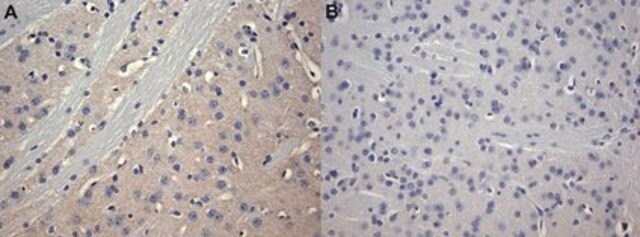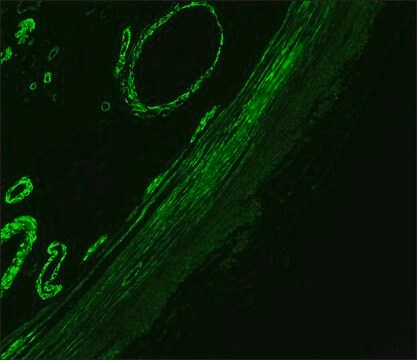A268
Anti-A1 Adenosine Receptor antibody produced in rabbit
affinity isolated antibody, buffered aqueous solution
About This Item
Produtos recomendados
fonte biológica
rabbit
Nível de qualidade
conjugado
unconjugated
forma do anticorpo
affinity isolated antibody
tipo de produto de anticorpo
primary antibodies
clone
polyclonal
Formulário
buffered aqueous solution
peso molecular
antigen 36-40 kDa
reatividade de espécies
human, rat, bovine (weak)
técnica(s)
immunohistochemistry (frozen sections): 1:100
immunoprecipitation (IP): suitable
western blot: 1:1,000
nº de adesão UniProt
Condições de expedição
dry ice
temperatura de armazenamento
−20°C
modificação pós-traducional do alvo
unmodified
Informações sobre genes
human ... ADORA1(134)
rat ... Adora1(29290)
Categorias relacionadas
Descrição geral
The A1AR is a glycoprotein of MW 36-40 kDa that can activate Gi and Go proteins in vitro In intact cells, agonist occupation of the A1AR has been shown to cause pertussis toxin-sensitive inhibition of adenylyl cyclase activity and, in some systems, a stimulation of phospholipase C resulting in mobilization of intracellular calcium stores. Activation of K+ channels by A1AR has been intensively studied in relation to its dramatic effects on the cardiovascular system
A1AR protein is highly expressed in brain (especially cerebellum, hippocampus, thalamus, and cortex) and spinal cord and in part, modulates neurotransmitter release In white adipocytes, A1AR inhibits lipolysis and stimulates glucose uptake. Other tissues also express A1AR including kidney and testis
Imunogênio
Aplicação
forma física
Exoneração de responsabilidade
Não está encontrando o produto certo?
Experimente o nosso Ferramenta de seleção de produtos.
Código de classe de armazenamento
10 - Combustible liquids
Classe de risco de água (WGK)
WGK 1
Ponto de fulgor (°F)
Not applicable
Ponto de fulgor (°C)
Not applicable
Equipamento de proteção individual
Eyeshields, Gloves, multi-purpose combination respirator cartridge (US)
Escolha uma das versões mais recentes:
Já possui este produto?
Encontre a documentação dos produtos que você adquiriu recentemente na biblioteca de documentos.
Nossa equipe de cientistas tem experiência em todas as áreas de pesquisa, incluindo Life Sciences, ciência de materiais, síntese química, cromatografia, química analítica e muitas outras.
Entre em contato com a assistência técnica







